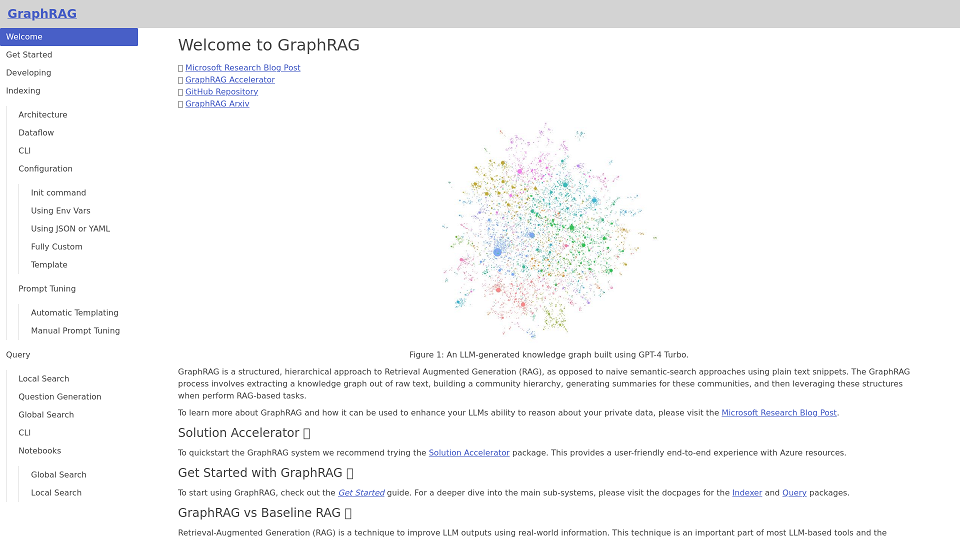GraphRAG
Welcome to GraphRAG
GraphRAG is a structured, hierarchical approach to Retrieval Augmented Generation (RAG) that leverages knowledge graphs to enhance LLMs' ability to reason about private data. It involves extracting a knowledge graph, building a community hierarchy, generating summaries, and using these structures for RAG-based tasks. GraphRAG outperforms traditional RAG methods, especially when connecting disparate information and understanding complex concepts.

GraphRAG Introduction
GraphRAG is a sophisticated approach to Retrieval Augmented Generation (RAG) that leverages the power of knowledge graphs to enhance the reasoning abilities of Large Language Models (LLMs) when dealing with complex information. Unlike traditional RAG methods that rely on simple semantic search using plain text snippets, GraphRAG employs a structured, hierarchical approach to information retrieval and synthesis.
Key Features of GraphRAG
GraphRAG distinguishes itself from conventional RAG techniques through its unique approach and capabilities:
1. Knowledge Graph Extraction
GraphRAG employs LLMs to analyze raw text data and extract a knowledge graph. This graph represents entities as nodes and their relationships as edges, providing a structured representation of the information.
2. Community Hierarchy Construction
The extracted knowledge graph is further organized into a hierarchical structure of communities using advanced graph machine learning techniques like the Leiden algorithm. This hierarchy allows for understanding information at different levels of granularity.
3. Community Summarization
LLMs are employed again to generate comprehensive summaries for each community within the hierarchy. These summaries provide a condensed overview of the key information contained within each community.
4. Enhanced Querying Capabilities
GraphRAG offers two primary query modes:
- Global Search: Allows for answering holistic questions about the entire dataset by leveraging the community summaries. This is particularly useful for identifying themes, trends, and overall understanding.
- Local Search: Enables reasoning about specific entities by exploring their connections, relationships, and associated concepts within the knowledge graph. This is beneficial for targeted information retrieval.
5. Prompt Tuning for Domain Adaptation
GraphRAG allows for fine-tuning prompts to adapt to specific domains and improve performance. This customization ensures optimal results tailored to the dataset.
Advantages of GraphRAG
GraphRAG offers significant advantages over baseline RAG approaches:
- Improved Reasoning about Complex Information: By representing information as a graph, GraphRAG enables LLMs to connect disparate pieces of information through shared attributes, leading to more insightful and comprehensive answers.
- Enhanced Summarization and Holistic Understanding: The community summaries provide a high-level overview of different sections of the data, facilitating a deeper understanding of the entire dataset.
- Effective Handling of Private Datasets: GraphRAG excels in reasoning about private datasets, which are data that the LLM has not been trained on, such as proprietary research or internal documents.
Summary
GraphRAG represents a significant advancement in RAG by incorporating knowledge graphs and hierarchical structures. This approach enhances the ability of LLMs to reason about complex information, summarize large datasets effectively, and handle private data with greater accuracy. GraphRAG's unique features and capabilities make it a powerful tool for unlocking valuable insights from textual data.
GraphRAG Frequently Asked Questions
What is GraphRAG?
GraphRAG is a structured, hierarchical approach to Retrieval Augmented Generation (RAG) that enhances LLMs' ability to reason about private data by extracting knowledge graphs, building community hierarchies, and generating summaries for these communities.
How does GraphRAG differ from Baseline RAG?
Unlike Baseline RAG, which relies on vector similarity for search, GraphRAG leverages knowledge graphs to improve question-answering performance, especially for complex information requiring connections between disparate data points and holistic understanding of large datasets.
What are the main steps involved in the GraphRAG process?
GraphRAG involves: 1) Indexing: Extracting knowledge graphs, building community hierarchies, and generating summaries. 2) Querying: Utilizing these structures to augment prompts for answering questions. 3) Prompt Tuning: Fine-tuning prompts for optimal performance with specific data.
What are the two primary query modes in GraphRAG?
GraphRAG offers two main query modes: 1) Global Search: For answering holistic questions about the entire corpus using community summaries. 2) Local Search: For reasoning about specific entities by analyzing their neighbors and related concepts.
Why is prompt tuning important in GraphRAG?
Prompt tuning is crucial for optimizing GraphRAG's performance with specific datasets. It involves customizing prompts to align with the data's nuances, leading to more accurate and relevant results.
What is the purpose of the Solution Accelerator?
The Solution Accelerator provides a user-friendly way to quickly deploy the GraphRAG system using Azure resources, offering an end-to-end experience for users.
How can I get started with using GraphRAG?
The "Get Started" guide provides a step-by-step introduction to using GraphRAG. For deeper insights into the sub-systems, refer to the documentation for the Indexer and Query packages.
What are the limitations of Baseline RAG that GraphRAG aims to address?
Baseline RAG struggles with: 1) Connecting disparate information requiring traversal through shared attributes. 2) Holistic understanding of summarized semantic concepts in large datasets or documents. GraphRAG tackles these limitations through its knowledge graph approach.
How does GraphRAG handle entity resolution?
GraphRAG uses a conservative approach to entity resolution, aiming to avoid information loss. It currently employs LLMs to identify and merge entities representing the same real-world entity, with ongoing exploration of non-destructive techniques.
What is the role of community summarization in GraphRAG?
Community summarization generates reports for each community in the knowledge graph, providing high-level understanding at different levels of granularity. These summaries aid in navigating and comprehending the graph's structure and content.